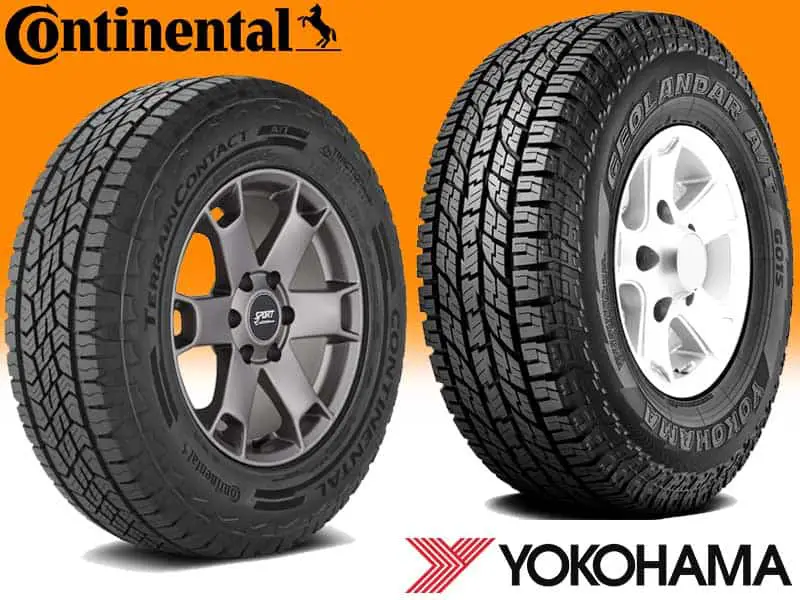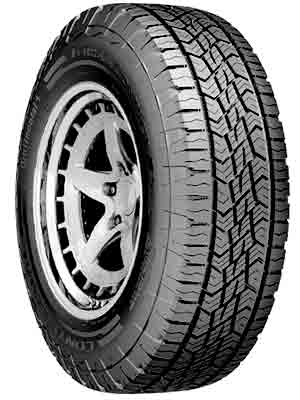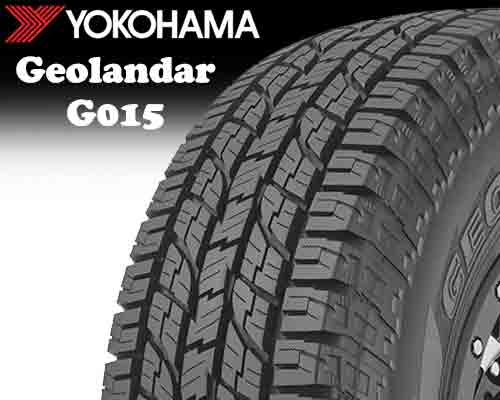Continental TerrainContact A/T vs Yokohama Geolandar A/T G015: Both AT (All-Terrain) tires designed to fulfill the needs of daily commutes as well as off-road driving. They are best suited for crossovers, light trucks, and SUV’s. And both of them were compared under same sizes (275/70R18), where Geolandar’s tread depth is 18/32″ and other one has 16/32″.
The TerrainContact has very strong closed shoulders that even contact between the road and the tire’s surface and enhance steering while the Geolandar has 3D sipes that change shape as the tread wears off to maintain all-season traction.

Examine the treads on these tires closely. They hold the key to knowing which to choose. In fact if you visit my "tread design" page, picking the right tire would never bother you.
Table of Contents
Comparing Yokohama Geolandar with Continental TerrainContact
Continental TerrainContact A/T

Yokohama G015 AT


Vs

The TerrainContact has a mild tread pattern that features stable tread blocks along with closed shoulders that offer a very short braking distance and good handling on dry pavements.
The full-depth sipes combined with the edge of the block traction grooves can eliminate water and enhance traction in wet and snowy conditions.
The tread compound also contains silane additives that further improve the wet grip of the tire. However, the grooves are not deep enough so it does not handle deep muddy terrains very well.
On the other hand, the Geolandar has an aggressive tread pattern. Its circumferential and edge tech grooves expel water from beneath the tread to help avoid hydroplaning and also provide more biting edges for better mud and snow traction.
It has 3D sipes that change shape as the tread wears off to maintain effective cleansing and traction in any terrain.
On-Road Traction Comparison
The TerrainContact provides great on-road traction as it is designed mainly keeping on-road performance in mind.
The open tread pattern with large tread blocks provides stability along with good and responsive handling. The tire is made of a soft rubber compound with Silane additives so it grips the road better.
The closed shoulder design provides a very short braking time on dry roads.
Geolandar also offers good on-road traction, The shoulder and lug grooves have road-hugging properties. They grip onto the roads to provide good traction. The 3D sipes present in a three-tier pyramid design offer stiffness on dry surfaces.
When it comes to wet on-road traction, the TerrainContact has a Traction Plus technology that ensures maximum traction on dry and wet roads.
The large number of full-depth sipes present effectively eliminate water and prevent hydroplaning when driving on wet roads.
The tires do not hydroplane even when passing over large puddles.
Meanwhile, the Yokohama’s tire here has four wide straight grooves that pass through the tread circumferentially and expel water from beneath the tread to increase the drainage performance of the tire on wet surfaces.
The 3D sipes present also evacuate water effectively. The tire is manufactured using the Enduro compound that makes it flexible in the rain.
Comparing Off-Road Traction
The TerrainContact is not good in off-road terrains. The Director of Marketing of Continental tires himself has recommended this tire for people who spend 90 percent of their time on-road and 10 percent off-road.
On the other hand, Geolandar provides superior off-road performance.
Let’s see how they perform on different types of terrains:
Performance on Dirt
In dirt off-road terrains, the large and stable tread blocks along with a closed shoulder prove to be sufficient enough to provide good handling and cornering and ensure good dirt traction.
The Geolandar’s tread pattern features deep circumferential grooves for successful and effective dirt evacuation and increased traction.
Performance on Mud
In mild to moderate mud, TerrainContact can provide decent traction thanks to the large number of sipes present which sweep away the mud stuck in between the tread blocks.
But when the mud gets deep, the sipes are not enough and grooves have to play their role. The lack of depth in grooves of the TerrainContact results in deficient cleansing of the tread from mud and hence reduced traction.
Geolandar has two types of grooves present in the tread pattern. The circumferential and edge tech grooves provide better mud traction by cleaning the tread and expelling mud from beneath the tire.
The mud terrain performance of Geolandar however decent and better than the TerrainContact is still not great.
Performance on Rocks
Both tires contain only a two-ply casing instead of a three-ply one.
So, they are not the best choice for driving on rocky terrains with sharp rocks. Especially, the TerrainContact that has a mild tread pattern that does not provide enough traction over large rocks.
Geolandar however has an aggressive tread pattern and also comes with protectors present on its sidewall to defend punctures that come from sharp rocks. So, we consider it the better choice for rocky terrains.
Performance on Snow
We found Geolandar’s snow performance to be pretty good. The edge tec grooves create biting edges that dig into the snow and provide good grip and handling.
The TerrainContact also has gripping teeth inside the groove that lock on the snow and improve the grip. The large number of sipes in the TerrainContact also contribute towards better snow traction. One thing to note is that while both tires are M+S rated, the Geolandar is stamped with the additional three-peak mountain snowflake (3PMSF) emblem that designates it as severe snow rated.
So, you can expect better performance from the Geolandar in deep snow.
Comfort Comparison
The TerrainContact uses what they refer to as Comfort Ride technology to ensure a smooth ride.
The distinctive tread pattern shifting makes the tires very easily controllable even when passing over bumps. Even if you hit a bump at high speed, the tire does not produce too much motion and the vehicle remains in your control.
Noise blockers are also present in the tread design that absorb the noise and offer a quiet ride.
The Geolandar provides good comfort levels at slow or moderate speeds but the faster you get, the bumpier the tire gets.
The same goes for the noise, at slow and medium speeds the tires are relatively quieter, but once you hit the gas, the tires can become irritability loud.
So, TerrainContact is better at providing comfort and noise reduction.
Durability and Treadwear
The open tread pattern along with large stable blocks make the TerrainContact durable.
On the other hand, the Geolandar is manufactured using the Enduro compound that is engineered to provide durability and flexibility in both on-road and off-road terrains.
It also makes the tire more resistant against punctures, cuts, scrapes, etc. The tire also has sidewall protectors to defend the sidewall from sharp rocks.
We found the Geolandar to be more durable compared to the TerrainContact.
If we talk about tread wear, the TerrainContact has big tread blocks and closed strong shoulders that increase tread life and uneven wear.
The even road surface contact that is provided by the flat contour tread shape also helps in increasing the tread life of the tire.
Terrain Contact also has tread wear indicators on it. They are narrow rubber bars placed in the grooves of the tire. As the tread wears down, the rubber bars become more visible indicating the decrease in tread depth of the tire.
On the other hand, the Geolandar features proprietary polymers that resist wearing. The tire profile is also optimized to distribute weight evenly to combat pre-mature and uneven wear.
The 3D sipes change shape when the tread wears to retain stiffness and prevent further wearing of the tread.
Both tires provide a 60000-mile tread warranty on paper. In real-life scenarios, the TerrainContact has gone up to 65000 miles while the Geolandar provides the mentioned 60000-mile projected tread life.
Price Differences
Both tires are expensive compared to other AT tires available in the market. The Geolandar however is slightly cheaper than the TerrainContact. Both provide somewhat similar tread life.
Quick Summary
- TerrainContact is the better choice if you are going to do more on-road driving.
- The Continental TerrainContact provides better on-road traction because it has a mild tread design with large and stable blocks that provide great road grip and handling. Its cornered shoulders provide very short braking times on roads whereas the full depth sipes prevent hydroplaning on wet surfaces.
- Yokohama Geolandar provides better off-road traction because it is made of a strong tread compound and has an aggressive tread design that features four circumferential grooves along with a protected sidewall that in combination offer good off-road traction and durability.
- TerrainContact provides better noise reduction and comfort levels.
- Geolandar is more durable compared, especially on off-road terrains.
- Both tires provide a good tread life, however, TerrainContact provides a slightly longer tread life.








